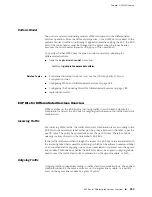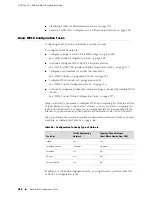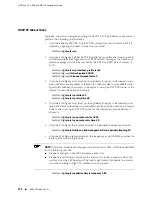
Uniform Model
The uniform model of tunneling renders MPLS transparent to the differentiated
services operation. From the diff-serv perspective, it is as if MPLS is not used. In the
uniform model, if traffic conditioning is applied somewhere along the LSP, the EXP
bits of the inner header must be changed at the egress when the inner header
becomes the outer header (because of the pop of the outer label).
To specify whether MPLS uses the pipe or uniform model of tunneling for
differentiated services:
■
Issue the
mpls tunnel-model
command.
host1(config)#
mpls tunnel-model uniform
Related Topics
■
For detailed information about QoS, see the
JUNOSe Quality of Service
Configuration Guide
■
Configuring MPLS and Differentiated Services on page 299
■
Configuring the Tunneling Model for Differentiated Services on page 299
■
mpls tunnel-model
EXP Bits for Differentiated Services Overview
MPLS matches on the EXP bits for incoming traffic to set the traffic class/color
combination, and sets the EXP bits for outgoing traffic based on the traffic class/color
combination.
Incoming Traffic
For incoming MPLS traffic, the traffic class/color combination is set according to the
EXP bits in the outermost label, either per the policy attached to the label or per the
per-VR rules. The policy has precedence over the per-VR rules. Therefore, fabric
queuing is always based on the outer label's EXP bits.
If the traffic is label-switched through the router, the EXP bits value associated with
the incoming label that is used for switching—which can be either an outermost label
or an inner label after popping one or more outer labels—is passed onto the egress
line module. This behavior enables the EXP bits value to be copied to outgoing labels,
used to reset the traffic class/color combination on the egress module, or both.
Outgoing Traffic
Outgoing traffic is queued according to traffic class/color combinations. The applied
combination can be the same as was set on the ingress line module, or it can be
reset on the egress line module by egress IP policy.
EXP Bits for Differentiated Services Overview
■
259
Chapter 2: MPLS Overview
Summary of Contents for BGP
Page 6: ...vi ...
Page 8: ...viii JUNOSe 11 1 x BGP and MPLS Configuration Guide ...
Page 37: ...Part 1 Border Gateway Protocol Configuring BGP Routing on page 3 Border Gateway Protocol 1 ...
Page 38: ...2 Border Gateway Protocol JUNOSe 11 1 x BGP and MPLS Configuration Guide ...
Page 234: ...198 Monitoring BGP JUNOSe 11 1 x BGP and MPLS Configuration Guide ...
Page 236: ...200 Multiprotocol Layer Switching JUNOSe 11 1 x BGP and MPLS Configuration Guide ...
Page 542: ...506 Monitoring BGP MPLS VPNs JUNOSe 11 1 x BGP and MPLS Configuration Guide ...
Page 544: ...508 Layer 2 Services Over MPLS JUNOSe 11 1 x BGP and MPLS Configuration Guide ...
Page 610: ...574 Virtual Private LAN Service JUNOSe 11 1 x BGP and MPLS Configuration Guide ...
Page 624: ...588 VPLS References JUNOSe 11 1 x BGP and MPLS Configuration Guide ...
Page 680: ...644 Virtual Private Wire Service JUNOSe 11 1 x BGP and MPLS Configuration Guide ...
Page 724: ...688 Monitoring MPLS Forwarding Table for VPWS JUNOSe 11 1 x BGP and MPLS Configuration Guide ...
Page 725: ...Part 6 Index Index on page 691 Index 689 ...
Page 726: ...690 Index JUNOSe 11 1 x BGP and MPLS Configuration Guide ...
















































